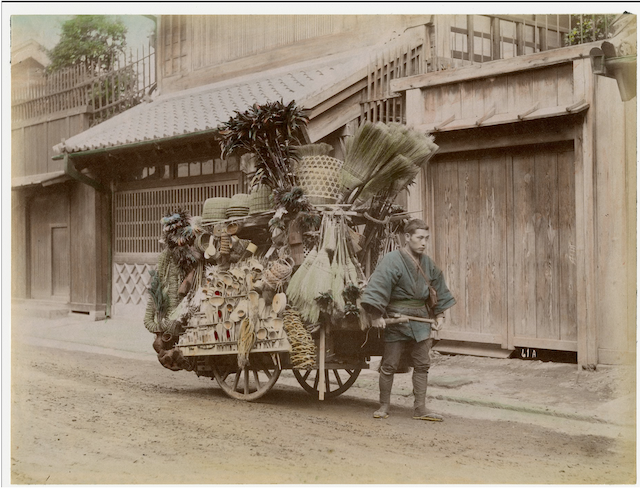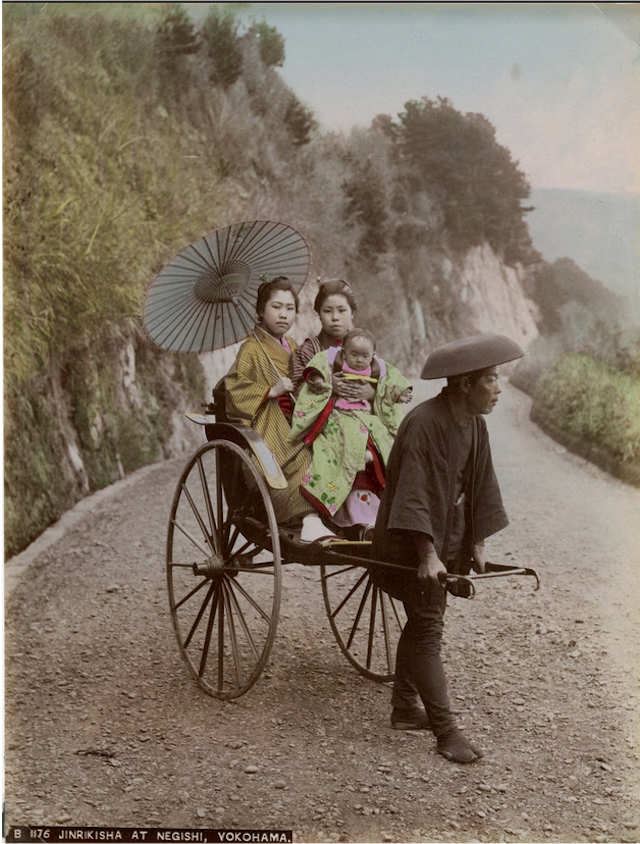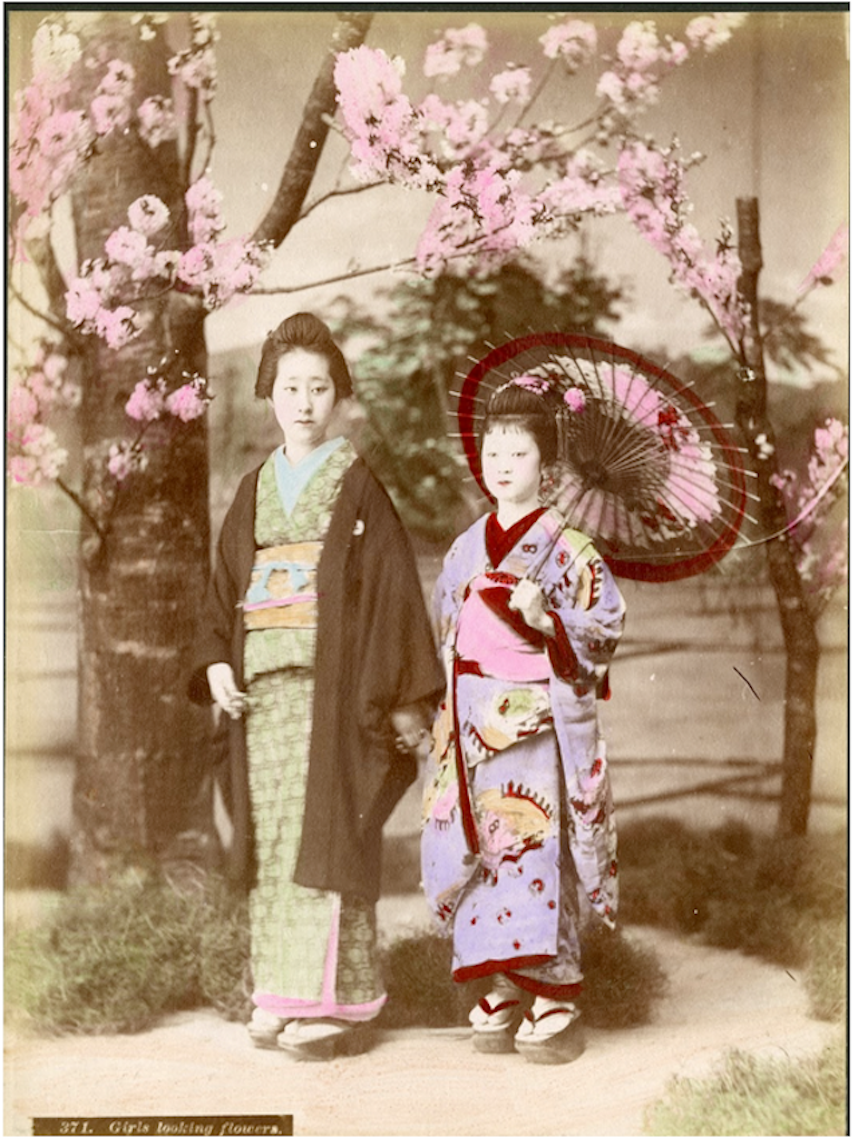
Daibatsu at Kamakura
This photo was taken at the Kōtoku-in Temple in Kamakura, Japan, showing two children playing around the Great Buddha of Kamakura -- a 43.8 ft and 267,000 pound bronze statue of Amitābha Buddha. Toning down the religious colors, this photo records and emphasizes children’s leisure instead of the religious figure. Without any visible communication between the children and the photographer, the photo is presented as a candid photography free from traces of artificial arrangement, thereby maximizing the significant and popular cultural theme of people’s daily life and interaction with nature. Moreover, because of the differences between the strict Western religion and the Japanese religious culture, the image showing the close contact between the children and the Buddha should be impressive to Westerners.

69 Sations of the Kisokaido, Niekawa, Takenouchi no Sukune and His Younger Brother Umashiuchi no Sukune
This woodblock print (ukiyo-e) was created in 1852 by Utagawa Kuniyoshi (1797-1861), an ukiyo-e artist of the late Edo period. It is characterized by vibrant colors and dynamic movements of two men who are placed in the center of be print, against a more subtle background. The two men here mentioned in the title are two brothers mentioned in the Kojiki and Nihon Shoki, books listing Japanese myths and legends. Kuniyoshi recreates a scene in the legend of the brothers here, where the brother plunges his hand into a boiling pot of water in order to prove accusations of rebellion wrong. Niekawa does not have any actual connection to this scene, but is rather associated to this scene with a pun, as Niekawa is similar to "Nieta kama" (boiling pot), as his Kisokaido series are all made based off of puns, rather than actual events at the place. Niekawa itself refers to an area within the Kisokaido Road which was one of the many shukubamachi - an area made to manage infrastructure and the town which developed around it - made within the road, currently equivalent to Shiojiri City of Nagano Prefecture.

Lantern Shade Painters
Kusakabe Kimbei was one of the most well-known Japanese photographers during and after the Meiji Restoration in Japan (1868), whose hand-colored photograph records the era of Japanese modernization. Kimbei reflects the family inherited and multi-person cooperative working methods of traditional Japanese handicrafts from the perspective of lantern making and repairing. Unlike the coloring filling in landscape photos, the careful use of a red on individual lanterns and on the cheeks and lips of each person in this photo highlights the parts of Japanese culture which cannot be replaced by western cultures. With the compact arrangement of lanterns, a unique cultural ambiance made entirely by local Japanese is reflected. As a consequence of mingling western photographic technology and Japanese culture, Kimbei’s photo, having documented the traditional human culture which has not been influenced by the west, serves as an unprecedented cultural object for westerners.

Club Hotel, Yokohama
This photo records the Club Hotel of Yokahama at either the end of the 19th century or the beginning of the 20th century, which was located in the port city Yokohama, one of the first to open up to Western trade and foreign communities. During this time, Japan was under the influence of western ideology and capital, and Yokohama, maintaining dual cultures, shows a bizarre mixture of distinct styles: the hotel with Western decors and local peddlers facing each other, and people dressing in western-style and traditional Japanese style passing by each other. These contrasting elements coexist peacefully in one shot. This photo shows the consequence of the cultural fusion, from which Yokohama was made into a compatible location under the influence of westernization, where Japanese culture and Western culture must exist in accordance with each other.

Man Pulling Cart
This image was plausibly taken after 1868 where Japan opened for foreign trade, considering that it is a tourist photo. The photo features a normal man whose name is unknown, in most likely an everyday situation, where it seems that he is pulling his cart for work or an errand. Unlike the woodblock print, the colors are much more subtle mainly featuring hues of blues and greens, and there is less movement felt. The background, a building and its gate,can also be clearly recognized. It represents everyday life in Japan, which was something exotic and strongly valued as tourist photos aimed towards a foreign audience. At the same time, because this was a tourist photo, where everyday life was idealized, we can also consider that this photo was staged to some extent like many other photos.

Jirikisha at Nekisha, Yokohama
In the 19th century, all across Asia, rickshaw pulling became an inexpensive and popular mode of transportation. Pictured in this photograph is a man pulling a rickshaw with two women and a baby. At the time the photograph wastaken, Yokohama was an up and coming port city with the establishment of many schools and newspapers. Rickshaws were made out of bamboo and rubber tires and they were a popular form of transportation in Japan. Rickshaw workers would provide door to door service for their customers. However, the rise of other modes of transportation resulted in the decline of rickshaws.

Girls Looking Flowers
This photograph depicts two girls dressed in kimono and holding an umbrella, surrounded by cherry blossoms. The artist used pink, purple, red, green, and blue coloring on the girls’ clothing and on the flowers in the background. The photograph is meant to look candid, as if the photographer stumbled across these two girls going for a walk in a garden, but on a second look it is clearly staged. The two girls are not mid-stride and rather thanbeing in a garden, they are standing in a studio set designed to look like a garden. This photograph and the view of Japan that it presents show how a traditional image at odds with Japan’s modernization appealed to western tourists.